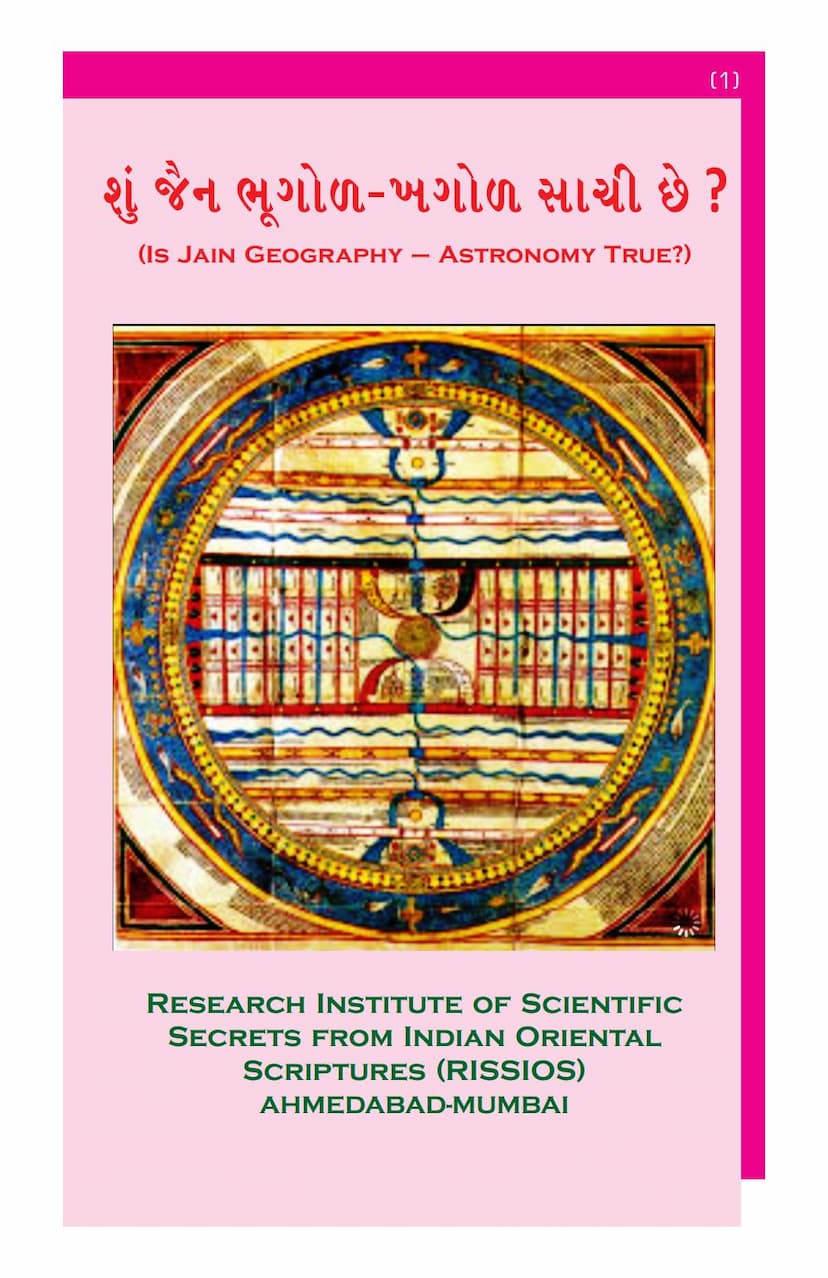Is Jain Geography Astronomy True
Added to library: September 1, 2025

Summary
This Jain text, titled "Is Jain Geography-Astronomy True?", authored by Acharya Vijay Nandighoshsuriji and Dr. Jivraj Jain, and published by the Research Institute of Scientific Secrets from Indian Oriental Scriptures (RISSIOS), addresses the long-standing discrepancies between the cosmographical descriptions in ancient Jain scriptures and modern scientific understanding of the universe.
The book's core aim is to reconcile these apparent contradictions and present Jain cosmology and geography in a way that is understandable and acceptable to the modern, scientifically-minded generation, thereby strengthening their faith in Jain philosophy.
Key Themes and Arguments:
-
The Problem: The text acknowledges that traditional Jain descriptions of the universe (Loka), including the shape and movement of the Earth, celestial bodies, and the structure of the cosmos, often seem to conflict with modern scientific observations and theories (e.g., heliocentric model, Earth's spherical shape, continuous movement of celestial bodies). This conflict leads to confusion and doubt among Jain scholars and the general public, especially the younger generation.
-
Critique of Traditional Approaches: The authors observe that some Jain scholars dismiss modern science as incomplete or flawed, while others adopt a "wait and see" attitude. The book proposes a third approach: re-interpreting the scriptural descriptions.
-
Dr. Jivraj Jain's Hypothesis: Dr. Jivraj Jain, a retired scientist with deep faith in Jainism, posits that the diagrams and maps found in ancient Jain texts are not literal geographical representations of the universe but are rather "pictograms" or "statistical charts" (Schematic diagrams). These were symbolic representations created using a specific methodology, perhaps to convey statistical or collective characteristics of celestial bodies and phenomena. The authors believe the intended meaning of this symbolic language might have been lost over time.
-
Reconciliation through Statistical Representation: The central argument is that the Jain description of the Loka can be understood as a statistical chart, which simplifies vast amounts of complex data about the universe into a manageable, understandable format. This approach allows for the vastness of the cosmos and the presence of multiple celestial bodies with potential life forms (as suggested by Jain cosmology) to be presented, without directly contradicting modern scientific findings. The authors suggest that Jain cosmology, when viewed as a statistical model, does not necessarily contradict modern science, but rather presents a different perspective.
-
The Role of Acharya Nandighoshsuriji: Acharya Nandighoshsuriji, a learned Jain scholar and scientist himself, supports Dr. Jain's hypothesis. He has studied the original Jain scriptures diligently and presents Dr. Jain's theory in a clear, accessible language, aiming to resolve many apparent contradictions. He emphasizes that Jain scriptures are not meant to be literal scientific textbooks but rather convey spiritual truths and ethical principles.
-
Emphasis on Jain Philosophy: The book asserts that the core tenets of Jainism, such as non-violence, compassion, truthfulness, and self-control, remain profoundly valid and are not challenged by scientific discoveries. The perceived conflict lies primarily in the interpretation of cosmographical details.
-
Historical Context and Scriptural Integrity: The text delves into the history of Jain scripture compilation, highlighting potential issues like oral traditions, transcriptions errors, compilation processes after natural calamities, and potential additions or modifications made by later scholars, especially in response to debates with other philosophical schools. It suggests that while the core spiritual teachings of the Tirthankaras are absolute truth, the specific cosmographical details might have been presented within the framework of the scientific knowledge and artistic conventions of their time.
-
Key Scientific Concepts Addressed: The book touches upon modern scientific concepts like:
- The spherical nature of the Earth and its rotation.
- The existence of multiple celestial bodies and potentially other inhabited planets.
- The concept of "Anti-Universe" and its possible parallels with Jain cosmology's descriptions of opposing regions.
- The vastness of the universe, the existence of galaxies, and the limitations of human knowledge in fully grasping cosmic realities.
- The nature of celestial bodies like the Sun and Moon, and the explanations for eclipses, referencing both Jain and modern scientific perspectives.
- The physical states of matter (solid, liquid, gas, plasma, etc.) and their potential connection to the descriptions of various Lokas and their inhabitants.
-
Call for Re-evaluation and Research: The book encourages a scientific and open-minded approach to studying Jain scriptures, urging readers to look beyond literal interpretations and explore the deeper, possibly symbolic or statistical, meanings. It calls for further research and a scientific debate to fully understand and reconcile the Jain worldview with modern scientific advancements.
In essence, "Is Jain Geography-Astronomy True?" argues that the seemingly contradictory descriptions of the universe in Jainism are not necessarily falsehoods but rather a different mode of representation – a symbolic or statistical language designed to convey profound cosmological and spiritual truths in a manner accessible to ancient understanding. The book offers a novel perspective that, by re-interpreting these ancient descriptions, can align them with modern scientific discoveries, thereby preserving and strengthening faith in Jain philosophy.